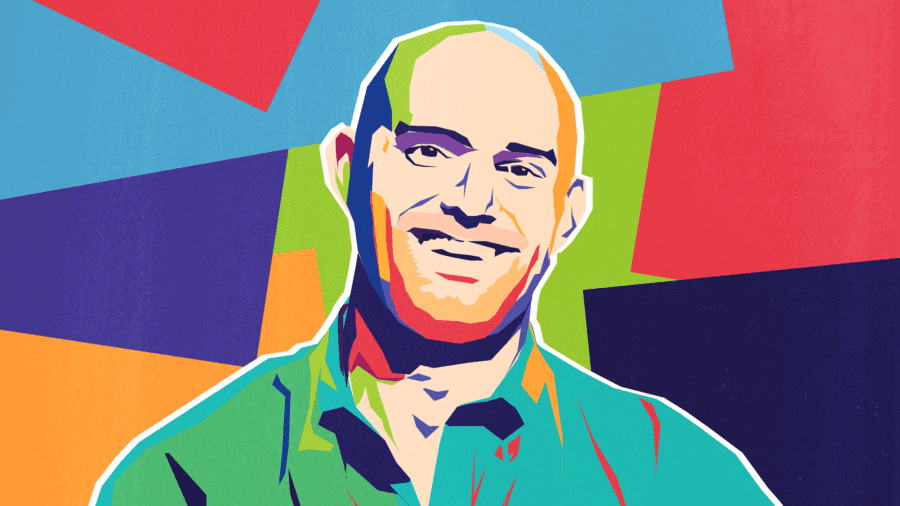
9 Hatha Yoga Poses & Breathing Techniques to Improve the Quality of Your Sleep
We all could use a little more sleep, couldn’t we?
Many nights, the ability to fall asleep seems like a puzzle that just can’t be solved. It doesn’t matter if you’ve checked off all the boxes on your “Things to Do Before I Lay Down” checklist, created the perfect sleeping environment, and set your thermostat to a cool 65 degrees — a good night’s rest may still evade you.
That inability to fall asleep could stem from many sources, which makes solving the mystery even more challenging. Maybe you’ve set a bedtime that’s a little too early or too late, your exercise could have been lacking that day, or perhaps those intrusive thoughts start to creep in and keep you up until 3 AM.
Whatever the case may be for you, we’ve got something you can add to your nightly routine to help you calm your mind and find stillness in your body before hitting the hay: Hatha yoga.
If you’ve been curious about using yoga for better sleep or including spiritual breathing exercises as one of your pre-bedtime activities, we’ve got you in this article! Keep reading to learn how hatha yoga may be the answer to your bedtime troubles.
What Is Hatha Yoga?
What’s the first thing that comes to mind when you think about yoga?
It could be an image of you bending yourself into what resembles a pretzel while standing on your head — by the way, “pretzel headstand” is definitely not a pose we’re familiar with, and we don’t recommend trying it. Or maybe you think about holding a “downward dog” pose while surrounded by baby goats.
Whatever you think of when you think of yoga, it goes without saying that yoga comes in many shapes and sizes, and each type of yoga serves its own purpose. Different breath techniques, flow styles, and poses all reap different benefits.
Many refer to hatha yoga as the gentle form of yoga. Much of its focus relies on simple, static poses that you hold for 30 seconds to a minute, coupled with breathing techniques that help you focus your mind and relax your body. Whether you attend a class or prefer yoga at home, your Hatha routine will typically include three things: breathing exercises, poses, and meditation.
When done correctly, Hatha goes beyond getting a good workout and increasing your yoga fitness. It can help you improve your balance, increase your mindfulness, and even help you drift off into dreamland.
Join In 200 Million+ On The Journey to Greatness
9 Hatha Yoga Poses to Improve Your Sleep Quality
As you start to wind down for the day, you may want to reach for the TV remote or hop on to your favorite social media app, but these habits may be harming your bedtime routine because of the extra stimulation from backlit screens.
Instead of spending pre-bedtime scrolling or binging your favorite shows, breaking out your yoga mat can help you feel more centered and relaxed before bed. Here are our nine favorite poses for pre-sleep:
1. Seated Pose or Sukhasana
It’s good to start and end with an easy pose when starting your bedtime yoga routine, and ease is exactly what Sukhasana means in Sanskrit.
To perform this pose, follow these simple steps:
- Come to a seat in the middle of your yoga mat (or on a blanket, the floor, etc., if a mat isn’t available)
- Cross one leg over the other, or draw one leg into your center followed by the other one
- Bring your hands to stillness on top of your knees or at your heart
Focus on your alignment while holding this pose. Think of your vertebrae as being stacked with your head over your heart and your heart over your pelvis.
2. Seated Forward Fold or Paschimottanasana
As you continue your evening yoga practice, it’s good to fully stretch your muscles and move mindfully from one pose to the next. After spending time in Sukhasana, a seated forward bend is a great next pose to transition into.
For this pose, you’ll stay seated on the ground. Then you need to:
- Extend your legs all the way forward, either touching or at hip-width apart (leave a little bend in the knees)
- Lengthen your arms and reach them forward
- Let your head become heavy and guide you into a fold as your hands grab your feet
Holding this pose will help you stretch your hamstrings and lower back, which will help your body feel more relaxed as you bring your day to an end. The more comfortable you are as you lie down at night, the better your sleep quality will be.
3. Seated Twist or Ardha Matsyendrasana
Once you’ve spent some time in your forward fold, rise back to your seated position. From here, it’s time to stretch out your spine with Ardha Matsyendrasana, also referred to as the half-fish pose or seated twist.
To get into your twist, follow these steps:
- Cross your right/left leg over your other leg and place your foot on the floor (You can also bend your grounded leg toward your opposite hip for a deeper stretch)
- Twist your body so your opposite elbow is on the outside of your elevated knee
- Repeat the twist on the other side
This stretch will help you stretch out your hips and back, which enables you to relax your core. Adding this pose to your nightly routine will help relieve the tension of the day before you lay down, especially if you spend extended periods sitting at a desk.
4. Mountain Pose or Tadasana
Tadasana is a fundamental standing yoga pose that serves several purposes. It helps you feel more grounded on and off the mat, increase your balance, and grow your mindfulness while standing in stillness.
Follow these instructions if you’re ready to give mountain pose a try:
- Stand with your legs either together or hip-width apart (Pay close attention to the ball joints of your big toes, pinky toes, and your heels)
- Let your hands fall to your sides and rotate your arms so your palms are facing forward
- Breathe in deeply and allow the stress of your day to melt away
Including mountain pose in a nightly yoga routine will help you bring your body to stillness as you prepare for bed. As you hold the pose, breathe in deeply and allow yourself to focus on achieving a good night’s rest.
5. Standing Forward Fold or Uttanasana
Transitioning from your mighty mountain pose, it’s time to fold into Uttanasana. This pose will look the same as a seated forward fold, only in a standing position.
To practice standing forward fold, you need to:
- Stand with your feet together or at shoulder-width apart
- Allow your head to grow heavy and guide your body forward
- Place your hands on the ground and continue to fold your body over
Even though this pose looks like a seated pose that’s shifted 90 degrees, the benefits of standing forward folds are similar to a headstand. Your upper body will work with gravity to relieve tension in your spine and neck, and you can also increase blood flow to the brain to help it function better as you prepare for bed.
6. Child’s Pose or Balasana
As you move from forward fold back to the ground, Balasana is a great pose to transition through. While in child’s pose, it’s easy to feel your breath and adjust its pattern for maximum pre-bedtime relaxation.
Here’s how to get to child’s pose from your standing forward fold:
- Plant your palms and come to all fours
- Lean your hips back and allow your tailbone to grow heavy
- Extend your arms and let your forehead kiss the ground (You can also bring your arms to your sides if that’s more comfortable)
Child’s pose provides an incredible stretch for the lower back, feet, arms, and shoulders if you leave them extended. If you want to level up the relaxation factor of this stretch, hug a pillow into your chest to help support the posture.
7. Fish Pose or Matsyasana
After you’ve lengthened your spine and taken the time to breathe in child’s pose, it’s time to transition into a full-on fish pose. Fish pose will continue the spine-lengthening goodness to help you feel your best as your head hits your pillow at night.
Follow these instructions to achieve piscine levels of relief in fish pose:
- Come to a seated position with your legs extended
- Place your hands underneath your hips with your palms on the floor
- Lean back onto your forearms and allow your head to fall backward
Matsyasana helps you relieve tension in your chest and upper back as you let your head grow heavy. It’s important to remember to breathe deeply and adjust yourself for comfort while practicing this pose — using a folded-up blanket or large pillow underneath your back will help support you in this shape.
8. Bridge Pose or Setu Bandha Sarvangasana
A great pose to transition into after fish pose is bridge pose, or Setu Bandha Sarvangasana. Bridge pose is excellent for releasing tension in your hips and helping your blood flow in the opposite direction of normal because your heart will be above your head.
Here’s how to come to bridge pose in your sleep-encouraging hatha yoga practice:
- Lay flat your back with your legs and feet tucked back to your hips (Knees elevated)
- Move from your center and lift your pelvis toward the sky
- Use your arms to support this pose by allowing them to press into the ground at your side
In addition to bridge pose’s relaxing properties, it also engages your legs and glutes to counterbalance the time you spend sitting throughout the day — which is a godsend for those of us that work at computers.
9. Corpse Pose or Savasana
Last but definitely not least is an excellent way to round out any yoga session: Savasana or corpse pose. This pose will not only help you get in the right headspace for bedtime, but it will also get you in a sleeping position.
This is how you properly execute Savasana in your nighttime yoga practice:
- Lay down completely on your mat
- Extend your legs forward and arms at your sides
- Let your body grow heavy
If you’re thinking, That’s just lying down — you’d be right. However, this pose does a couple of amazing things for your body. It allows you to be incredibly mindful and lets the stress of the day melt away.
Pay attention to the world around you during this pose: What do you smell? What can you hear? What can you taste? Then let those feelings move you toward a better night’s sleep.
These Three Breathing Techniques Will Maximize Bedtime Yoga Sessions
Each yoga pose mentioned above will help you wind down at the end of the day, but they are incredibly more effective when you couple them with proper breathing. Luckily, we have you covered there as well!
Three excellent breathing techniques to help you wind down and increase your mindfulness around bedtime include: alternate nostril breathing, belly breathing, and ratio breathing.
1. Alternate Nostril Breathing
You’d be correct if you think that alternate nostril breathing means breathing through one nostril at a time! But since you can’t close off your nostrils without extra assistance, your hands will come into play when implementing the technique.
Here are three easy steps to using alternate nostril breathing in your nightly yoga routine:
- Close off your left nostril with your left thumb and take a deep breath through your right nostril
- Hold your breath and close off your right nostril with your pinky and ring finger
- Exhale through your left nostril
You can repeat this process to help your body balance breathing between your right and left sides, and you can also play with which nostril you inhale and exhale through. Coupling this breathing technique with Sukhasana will help you increase your mindfulness and find balance before bed.
2. Belly Breathing
Belly breathing, or diaphragmatic breathing, is another breathing technique executed exactly as it sounds. As you implement this breathing method, you can use your hands to guide the breath in a seated or standing pose, or Shavasana.
To include belly breathing in your nightly yoga practice, follow these instructions:
- Place one hand on your abdomen and one on your chest
- Inhale deeply while focusing on moving your stomach outward (Your chest should not move during this breathing practice)
- Exhale deeply through pursed lips and contract your stomach muscles back to their original position
This method focuses your attention on the expansion of your diaphragm and allows you to calm your mind and center yourself during your pre-bed yoga practice. As you continue your nighttime routine, you can incorporate belly breathing through all poses.
3. Ratio Breathing
Ratio breathing is similar to belly breathing and helps you control your breathing by inhaling, holding that inhalation, and exhaling for specific counts.
One great breathing technique that helps you fall asleep is 4-7-8 breathing. Research conducted by Dr. Andrew Weil on this breathing exercise shows that 4-7-8 breathing acts as a natural tranquilizer and enables you to calm yourself before bed because it pulls your attention off of the world around you and focuses it onto your breath.
Here’s how you can unlock the sleep-inducing power of 4-7-8 breathing in your practice:
- Breathe into your diaphragm for four seconds
- Hold that breath for 7 seconds
- Release your breath through your mouth (making a “whoosh” sound) for 8 seconds
To get the most out of 4-7-8 breathing in your nighttime yoga routine, couple it with a seated position or a corpse pose — you can also move the pose into your bed itself. This combination will help you mindfully relax and peacefully drift off to sleep in no time.
You Can Improve Your Sleep with Hatha Yoga
Setting aside the time for yoga practice right before bed might not always be possible, especially if you’re concentrating on getting your family to sleep and downtime is limited. But your sleep will improve even if you can adopt one or two of these practices and limit your screen time before you call it a night.
Greatness Authors
Greatness Authors is a collection of writers, thinkers, curiosity experts, and students of the world who are committed to bringing you the most up-to-date, impactful, and inspiring information surrounding Greatness topics.

Do You Have to Be a Morning Person to Be Successful? Here’s What Both Sides Have to Say

9 Reasons You’re Tired All the Time & How to 10x Your Energy

How to Have a Healthy Romantic Relationship Even if You Share Different Beliefs

The 7 Best Vitamins to Naturally Promote Better, Uninterrupted Sleep According to Shawn Stevenson

The Science of Forming Healthy Habits & Letting Go of Bad Ones, According to Author James Clear










